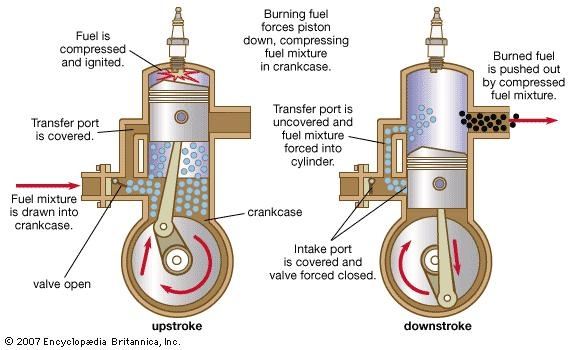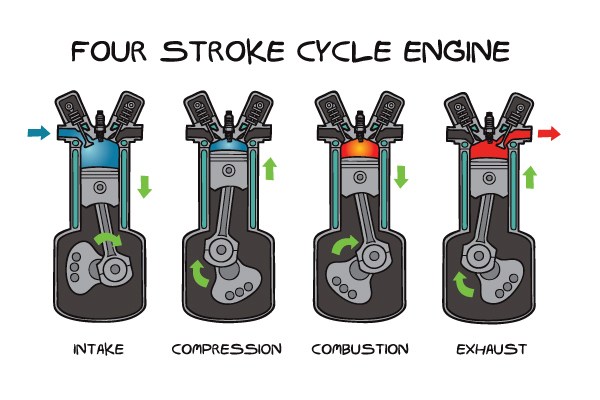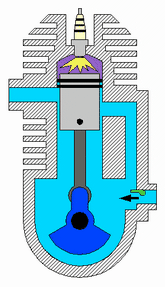We have seen how technology has advanced and how engines have been made into much more efficient ones. From prehistoric diesel engines to current highly sophisticated common rail engine, from 2-stroke to modern 4-stroke engine, and now even variable compression engines, all are a step forward towards better and more efficient internal combustion engines.
Also Read: Otto vs Atkinson Cycle Engines
In this blog, we will be discussing 2-stroke vs 4-stroke engine models. If you are in the 30s, you must remember old 2-stroke Yamaha bikes, or the low-roof Suzuki carry van, both of which used to make a lot of noise, and a lot of smoke. Those were the days of 2-stroke engines. But do not think that 2-stroke is a thing of a past. These engines are still widely used in various applications. The needs have, however, changed. The efficiency of an engine has taken priority over a lot of other things.
But efficient or not efficient, for an engine to work properly, it has to undergo a complete combustion process. This process is sub-divided into four processes. Now, these processes can either work in parallel (one or two in parallel) or can be individual, depending upon the type of engine. Let us see what these are and how they work:
What is a Stroke?
In order to know what these processes are, one must know what a stroke is. A stroke is a distance a piston travels in the combustion cylinder as it moves from the top dead centre (TDC – the topmost point of the working area of a piston) to the bottom dead centre (BDC – the bottom most point of the working area of a piston). Basically, a stroke can be said to be the number of time a piston moves in the cylinder. So if the piston travels four times in the cylinder, it is a 4-stroke engine. And if it travels only twice, it is a 2-stroke engine. In a four-stroke engine, the crankshaft completes two revolutions while in a two-stroke engine, the crankshaft only rotates once, per cycle.
The Four Strokes:
The four processes (or strokes) that occur during combustion in any type of engine are as follows:
Intake
– This stroke begins at TDC and ends at BDC. In this stroke, the intake valve must be in the open position while the piston pulls an air-fuel mixture into the cylinder by producing vacuum pressure in the cylinder through its downward motion.
Compression
– This stroke begins at BDC or just at the end of the suction stroke, and ends at TDC. In this stroke, the piston compresses the air-fuel mixture in preparation for ignition during the power stroke. Both the intake and exhaust valves are closed during this stage.
Power
– This is the start of the second revolution of the crankshaft. At this point, the crankshaft has completed once, a full 360-degree revolution. While the piston is at TDC (the end of the compression stroke), the compressed air-fuel mixture is ignited by a spark plug (in a gasoline engine) or by heat generated by high compression (diesel engines), forcefully returning the piston to BDC. This stroke produces mechanical work from the engine to turn the crankshaft.
Exhaust
– During the exhaust stroke, the piston once again returns to TDC from BDC while the exhaust valve is open. This action expels the spent air-fuel mixture through the exhaust valve.
Now, these processes occur one by one in a four-stroke engine as the crankshaft completes its two revolutions while for a two-stroke engine, one or two of these processes occur in parallel – one stroke is compression stroke which also encompasses the power stroke while the other is exhaust stroke which also has the intake stroke in parallel. The cycle of the 4-stroke engine is called Otto cycle, named after its inventor Nikolaus Otto.



Differences between 4-stroke and 2-stroke Engine:
| 4-Stroke Engine | 2-Stroke Engine | |
| One power stroke for two crankshaft revolutions | Engine is One power stroke for one crankshaft revolution | |
| Heavier flywheel is required to run to counter turning moment | Lighter flywheel is required because turning moment is countered by power stroke in each revolution |
|
| Engine is heavy | Engine is light | |
| Complicated design due to valve mechanism |
Simpler design due to the absence of valves | |
| Expensive | Cheaper | |
| Less mechanical efficiency due to more friction |
More mechanical efficiency due to less friction between moving parts |
|
| Fuel efficient and complete burning of fuel | Mixing of fuel with exhaust gases and less efficient |
|
| Requires more space | Requires less space | |
| Complicated lubricating system | Simpler lubricating system | |
| Less noisy | Noisier | |
| Consists of valves | Consists of ports | |
| More thermal efficiency | Less thermal efficiency | |
| Consumes less oil | Consumes more lubricating oil | |
Pros and Cons of a 4-Stroke Engine:
| Pros | Cons |
| More torque | Complicated design |
| More fuel efficiency | Less powerful |
| Less pollution | Expensive |
| More durability | |
| No need for extra addition of oil |
Pros and Cons of a 2-Stroke Engine:
| Pros | Cons |
| Simpler design | Less fuel efficiency |
| More powerful | Needs consistent oil addition |
| Position of engine does not matter | More pollution |
| Wastage of fuel | |
| Improper combustion |
For all the old petrolheads who have driven 2-stroke engines, what do you guys say? Do you still miss those, or it’s a good thing they are not as common now as they used to?
Let us know in the comments section below.

